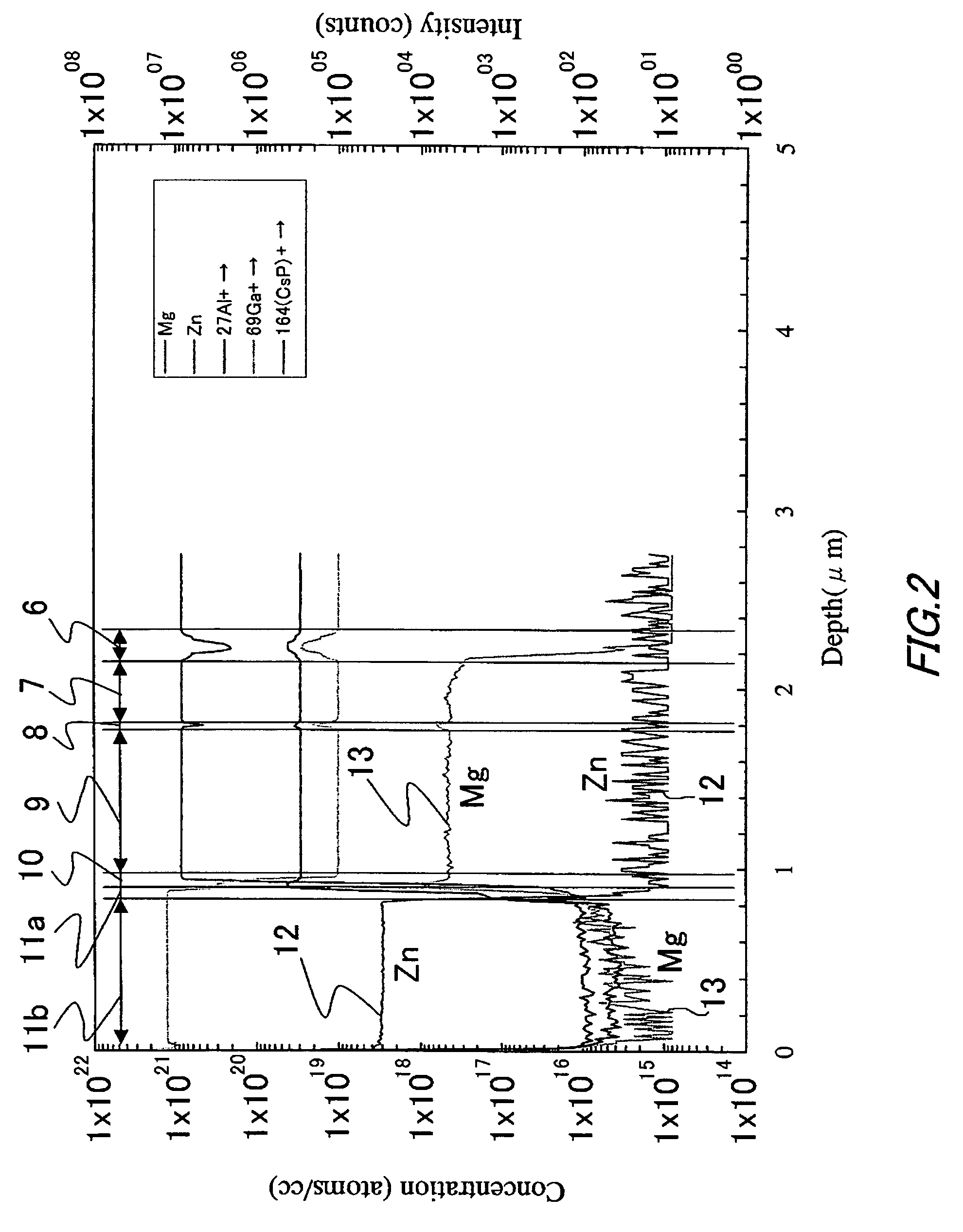Epitaxial wafer for semiconductor light-emitting devices, and semiconductor light-emitting device
a light-emitting device and semiconductor technology, applied in the direction of semiconductor devices, basic electric elements, electrical appliances, etc., can solve the problems of deterioration of device characteristics and reliability, increase of threshold current and operating current, and impaired crystal quality of active layer, etc., to achieve excellent high-power and high-temperature characteristics, no deterioration of luminescent characteristics, and less diffusion
- Summary
- Abstract
- Description
- Claims
- Application Information
AI Technical Summary
Benefits of technology
Problems solved by technology
Method used
Image
Examples
embodiment 1
[0106]As shown in FIG. 1, on an n-type substrate 1 made of GaAs are sequentially epitaxially grown an n-type buffer layer 2 made of GaAs, a lattice-matched n-type buffer layer 3 made of GaInP, and a lattice-matched n-type cladding layer 4 made of (Al0.7Ga0.3) 0.5In0.5P, on which are sequentially grown an undoped guide layer 5 made of (Al0.5Ga0.5)0.5In0.5P, a multi-quantum well (MQW) active layer 6 constituted by a barrier layer and a strained GaInP well layer, a Mg-doped p-type first cladding layer 7 made of (Al0.7Ga0.3) 0.5In0.5P, a p-type etch stop layer 8 made of GaInP, a Mg-doped p-type second cladding layer 9 made of (Al0.7Ga0.3)0.5In0.5P, and a Mg-doped p-type intermediate layer 10 made of GaInP.
[0107]And on the top portion are sequentially grown a Mg-doped p-type cap layer 11a made of GaAs serving as the zinc diffusion suppression layer of the invention, and a Zn-doped p-type cap layer 11b made of GaAs. Here, the Mg-doped p-type cap layer 11a on the Mg-doped p-type second cla...
embodiment 2
[0111]For the zinc diffusion suppression layer (Mg-doped p-type cap layer 11a) of the invention, the amount of Mg doped can be freely set to some degree. Accordingly, as another embodiment, by setting the carrier concentration of the Mg-doped p-type cap layer 11a that is the zinc diffusion suppression layer to 4×1018 cm−3, and likewise the carrier concentration of the Zn-doped p-type cap layer 11b to 4×1018 cm−3, similar effects can be exhibited.
embodiment 3
[0112]As shown in FIG. 3, on an n-type substrate 21 made of GaAs are sequentially epitaxially grown an n-type buffer layer 22 made of GaAs, an n-type DBR (distributed Bragg reflector) layer 23 made of a thin-film multi-layer structure of Al0.5Ga0.5As and AlAs, and an n-type cladding layer 24 made of (Al0.7Ga0.3)0.5In0.5P, on which are sequentially grown a multi-quantum well (MQW) active layer 25 constituted by a barrier layer and a strained GaInP well layer, a Mg-doped p-type cladding layer 26 made of (Al0.7Ga0.3)0.5In0.5P, and a p-type current diffusion layer 27 made of GaP.
[0113]And on the top portion are sequentially grown a Mg-doped p-type cap layer 28a made of GaAs serving as the zinc diffusion suppression layer of the invention, and a Zn-doped p-type cap layer 28b made of GaAs. Here, the Mg-doped p-type cap layer 28a on the Mg-doped p-type cladding layer 26 side is 70 nm in thickness and 1×1018 cm−3 in carrier concentration, and the Zn-doped p-type cap layer 28b on the upper s...
PUM
 Login to View More
Login to View More Abstract
Description
Claims
Application Information
 Login to View More
Login to View More - R&D
- Intellectual Property
- Life Sciences
- Materials
- Tech Scout
- Unparalleled Data Quality
- Higher Quality Content
- 60% Fewer Hallucinations
Browse by: Latest US Patents, China's latest patents, Technical Efficacy Thesaurus, Application Domain, Technology Topic, Popular Technical Reports.
© 2025 PatSnap. All rights reserved.Legal|Privacy policy|Modern Slavery Act Transparency Statement|Sitemap|About US| Contact US: help@patsnap.com



